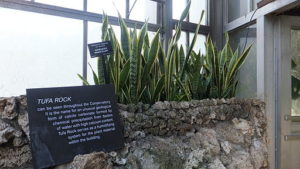
Photo: Snake Plant in Rock Planter, Attribution: By JLHA3050 (Own work) [CC BY-SA 3.0 (http://creativecommons.org/licenses/by-sa/3.0)], via Wikimedia Commons
(Please see last page or sidebar link for Table of Contents.)
Have we applied the technology that helps our indoor plants purify air?
The use of plants as botanical air filters to clean and purify air was developed in the 1970s, in connection with NASA research. The idea rapidly gained popular acceptance, but never gained traction. The reason appears to lie in the difficulty of properly applying the technology which makes plants effective air filters. This article explores:
1. the history of the indoor plant air purification revolution,
2. why it has had limited success, and
3. what we need to do to use plants effectively to clean indoor air.
What is indoor air pollution?
When we enter an interior where there are fumes from carpets or furnishings made of synthetic materials, we are exposed to a sometimes barely perceptible type of indoor air pollution known as off-gassing, where volatile organic chemicals (VOCs) continuously enter indoor air.
As a result of this off-gassing, we might detect a chemical odor, or we might experience sneezing, coughing, or watering of the eyes, without being able to identify the cause.
Before the 1970s, indoor air pollution generally was limited to molds, bacteria, or particulate matter such as dust and animal dander, except where chemicals were in use. Older buildings were not tightly sealed, and were naturally ventilated through leaks, cracks, and open doors and windows.
Why did indoor air pollution increase after the 1970s?
The problems associated with indoor air quality began to develop following the oil embargo of 1973 and the energy crisis of 1979, when oil shortages and price increases caused a need for adjustments in local economies to become more efficient in petroleum usage.
Source: Wikipedia on the energy crisis.
Until the 1970s, building codes were generally developed at the local (city) level (building codes discussion).
In response to the oil and energy crises, national and international agencies formed to develop “model building codes” to promote energy efficiency.
Since the energy crises of the 1970s, regulations to increase the energy efficiency of buildings typically have required sealing potential leaks allowing possible entry of outside air. The reduction in ventilation with outside air due to tighter seals, energy efficient glass, and lower air exchange rates resulted in the accumulation of volatile organic chemicals (VOCs), microorganisms, and particulates. The term “Sick Building Syndrome” entered common usage.
Source: NASA phytoremediation article.
Economists have estimated that the adoption of more efficient products and services [as a result of these newly developed codes and standards] is responsible for 60-75% of the increase in energy productivity since 1970.
Source: Commission report.
But while we became energy-efficient, we also became sick without realizing it.
According to the article quoted above, studies have linked indoor air pollution to increased occurrence of Parkinson’s disease, brain tumors, multiple chemical sensitivity and other nervous system disorders. A study of the incidence of asthma between 1980 and 1994 linked inadequate ventilation to a 74% increase in asthma, with preschool children in the United States showing a 160% increase.
Click next page to see how plants became part of the indoor air pollution problem.



